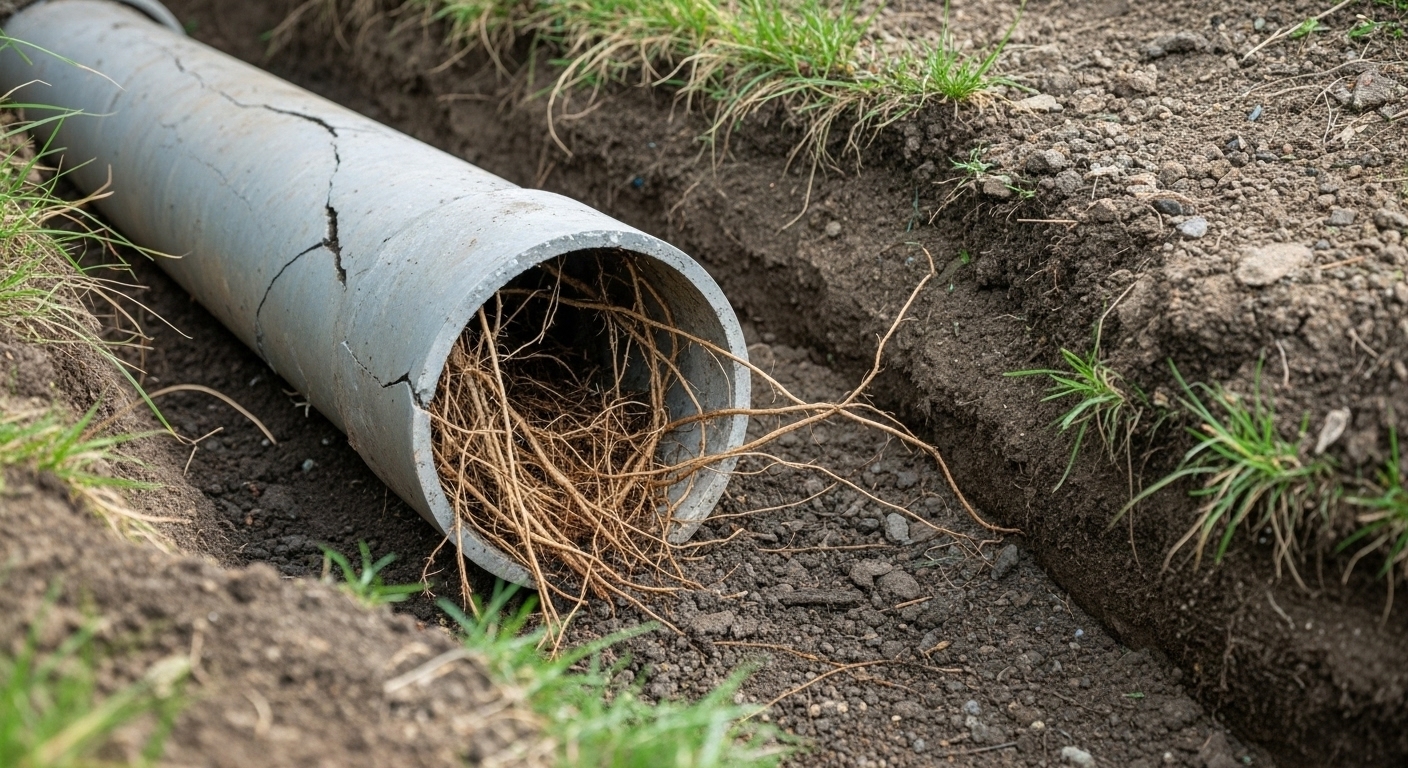Tree roots are persistent, invasive, and indifferent to property lines. When they discover a pathway into your sewer system, they seize it, causing clogs, leaks, and even catastrophic pipe failures.
Roots really don’t care where your sewer line runs—but Rooter Solutions’ licensed plumbers do. That’s why we’re here to go over everything you’ve ever wondered about tree root intrusion. Learn how our team identifies, treats, and prevents this underground menace before it turns into a disaster.
What Is Root Intrusion in Sewer Lines?
Root intrusion occurs when tree or shrub roots infiltrate sewer pipes through tiny fissures, loose joints, or deteriorating sections of pipe. Drawn by the constant moisture and nutrients flowing through sewer lines, roots thread their way in and begin to expand.
At first, you may not notice. But as the roots thicken, they can cause partial blockages that disrupt the flow of wastewater. Warning signs often include slow drains, toilets that gurgle after flushing, or the faint but unmistakable odor of sewage around your property. These early indicators suggest roots may already be gaining ground inside your pipes.
Why Roots in Sewer Lines Are a Serious Problem
Roots are relentless once inside a sewer line. What begins as a small intrusion can escalate into:
- Clogs and backups that force wastewater back into sinks, tubs, or floor drains.
- Pipe fractures occur as growing roots exert pressure, widening cracks, and breaking pipe walls.
- Flooding and property damage, particularly if sewage escapes into the yard or basement.
- Escalating costs, since waiting often transforms a minor repair into a full-scale replacement.
In fact, roots are responsible for more than half of all sewer blockages, which shows just how big a problem they can become if not taken care of early. Left untreated, roots can render your system unsafe and unstable.
How Plumbers Diagnose Root Intrusion
Modern plumbing diagnostics take the guesswork out of root problems. Using a sewer camera inspection, plumbers thread a high-resolution camera into the line to pinpoint blockages and gauge the extent of damage. This allows them to see whether roots are isolated to one section or spread throughout the system.
Once the root invasion is documented, your plumber should provide an informed plan of action. Sometimes the pipes can be salvaged with cleaning and reinforcement. However, in more severe cases, a sewer line replacement or trenchless lining may be necessary. The key to effectively resolving the issue is a transparent assessment so homeowners understand how urgent the situation is and their available options.
How Plumbers Remove and Treat Roots in Sewer Lines
Eradicating roots is not a one-size-fits-all process. That is why how best to kill the tree roots in your sewer line will depend on the condition of your pipes. Plumbers may use:
- Hydro jetting, which sends high-pressure water streams through the line to blast roots apart and clear debris.
- Mechanical augers, equipped with rotating blades that cut through root masses and restore flow.
- Chemical treatments, designed to discourage regrowth after the physical obstruction is removed.
The removal process should go beyond just clearing the line. It should also address the compromised sections of the pipe so that roots cannot easily return. Without repairing the structural weakness, root intrusion will almost certainly happen again.
Will Root Intrusion Require Replacement of Pipes?
Not every case demands new pipes, but sometimes replacement is the only lasting solution. Factors include:
- The material and age of the existing sewer line.
- The extent of the intrusion and whether the pipe walls are intact.
- Recurrence of blockages despite prior treatments.
For moderate damage, trenchless sewer repair and lining offer a minimally invasive fix. A resin-coated liner is inserted and hardened, creating a seamless new pipe inside the old one. This avoids large-scale excavation while sealing out roots.
When the damage is extensive, such as collapsed sections or crumbling clay pipes, a full replacement may be the safest option. Though more involved, it will help your system function reliably for decades.
Preventing Root Intrusion From Returning
Once root intrusion has been managed, prevention is critical. Helpful measures include:
- Routine sewer maintenance, such as scheduled cleanings and periodic camera inspections.
- Strategic landscaping, planting trees and shrubs at a safe distance from sewer lines.
- Proactive repairs, sealing cracks or reinforcing vulnerable joints before roots can exploit them.
These practices extend the life of your system and minimize the risk of sudden, costly emergencies.
Sewer Line Protection Starts With Proactive Care
Tree root intrusion is a clear reminder of how powerful root systems can be when searching for water and nutrients. Once roots grow into a sewer line, they won’t stop until they cause clogs, leaks, or even pipe bursting.
Removing tree roots is important, but taking steps to repair damage and prevent future growth is what truly protects your home. By staying proactive, you can guard against intrusion, preserve your pipes, and make sure your plumbing system stays reliable long into the future.
Call Rooter Solutions for Expert Sewer Line Repair & Replacement in Santa Barbara & Ventura County
Root intrusion doesn’t need to take over your property. With over 30 years of experience, Rooter Solutions provides Santa Barbara and Ventura County homeowners with advanced diagnostics, trenchless technology, and reliable repair or replacement services for all your plumbing issues.
Available 24/7, our team is committed to protecting your property, your budget, and your peace of mind. When roots find their way into your system, call Rooter Solutions at (805) 203-8111 or contact us online to remove the intrusion and restore your plumbing system before disaster strikes.




 805-203-8111
805-203-8111  Leave a Review
Leave a Review